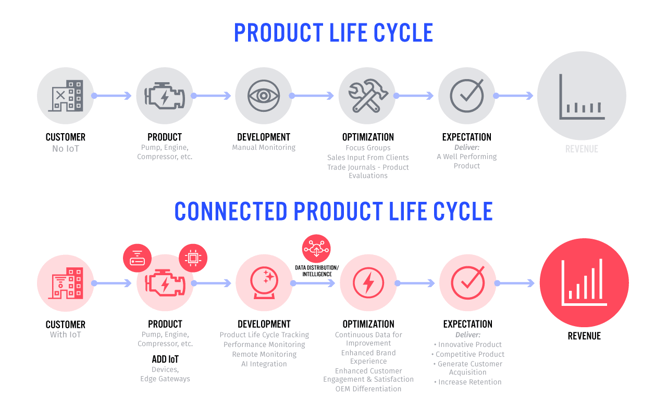In parts 1 and 2 of this blog series, we looked at the main factors impacting IoT initiatives and how companies can deliver value by building IoT into their products. Now, let’s dive into the various levels (or dimensions) of current value and potential new value with IoT.

Value Level 1: Product
Every product delivers some basic form of utility. Simply put, this is the product’s core function:
- The lawn mower cuts grass.
- The industrial pump moves liquids or fluids at desired rates.
- The compressor pressurizes and distributes air or other gases.
With a product, improvements in key areas such as speed, reliability, controllability, efficiency, and output can be significant and beneficial. Yet, they are still part of enhancing performance at the product level, and the improvement relates exclusively to what the equipment does and how well it performs.
Augmenting product performance with the addition of IoT affords the next level of performance. The user/operator gains valuable data from an unlimited number of devices and machine locations by adding a preinstalled gateway capable of sourcing and delivering the data. Deeper learning — faster and better than ever possible with readings on a clipboard or keyed into a database — is suddenly possible.
Value Level 2: Development
With IoT, higher-level value delivery is realized through enhanced learning and draws from the ability to sense, monitor, and gauge equipment performance. It also allows the company to organize and visually present, store, and share operating data. However, this is not the difference between riding a horse or driving a car. Instead, value delivery through enhanced learning leads to significant new user benefits and experiences, such as these:
- Performance Monitoring
- Insight Discovery
- Trend Identification
- Product Life Cycle Tracking
- Custom Data Applications
- Remote Monitoring
- Condition-Based Maintenance
- Predictive Maintenance
Value Level 3: Optimization
Access to ongoing data and new insights around product usage and performance expands value by optimizing benefit delivery. A well-performing machine with good brand value and high-quality ratings without IoT will undoubtedly improve with IoT because it can then offer more benefits to users and the manufacturer, including:
- Continuous Data for Improvement
- Cost Management, Efficiency, and Savings
- Enhanced Brand Experience
- Individualized Experiences and Multi-Tenant Views
- Innovation Support
- Product Line Advancement and Distinction
- OEM Differentiation
- Enhanced Customer Engagement and Satisfaction
Value Level 4: Expectations
As innovation continues and accelerates, and with IoT becoming increasingly commonplace within the industrial equipment, higher expectations of a product’s performance also rise. It is similar to the expectation of video assistance, entertainment options, and other safety or comfort features in today’s automobiles. Consumers expect expanded value beyond the vehicle’s primary purpose of providing reliable transportation.
Adding IoT has the following advantages:
- Minimum Acceptable Product is Elevated
- Competitive Viability is Redefined
- Product Lines are Enhanced and Differentiated
- Relationship Retention is Strengthened
- Revenue Grows with Value Increase
As the value equation evolves, OEMs will enjoy new revenue streams. Monetization of the value follows along new value lines:
- Product: Equipment that functions better, more reliably, or more consistently is preferred and of greater value to users.
- Development: Sophisticated products rich in data are advantageous and worth more to users, potentially enabling exponential revenue growth on a per-product-unit basis.
- Optimization: Connected products that deliver unique views with branded experiences, and leverage data and insights to create value beyond the expected norm, become preferred, promote long customer relationships, and merit higher revenue.
- Expectation: When OEMs strategically employ IoT to set and exceed new marketplace expectations rather than merely keep pace, they are more likely to be rewarded.
Just as automakers and their customers understand - and even expect - the benefits of enhancing the overall driving experience, manufacturers building connected products can realize significant additional intrinsic and monetary value simply by making IoT part of their offerings.
In part 4 of this blog, we will focus on why industrial equipment OEMs are particularly well matched to Losant’s strengths, focusing on actual, long-term advantages for their customers.
If you’d like to learn more about how Losant can help your organization meet its IoT application development needs, connect with us here.
| Download To Read the Complete Blog Series (702 KB) |
| Download To Get the Collection of Case Studies in This Series (1.48 MB) |